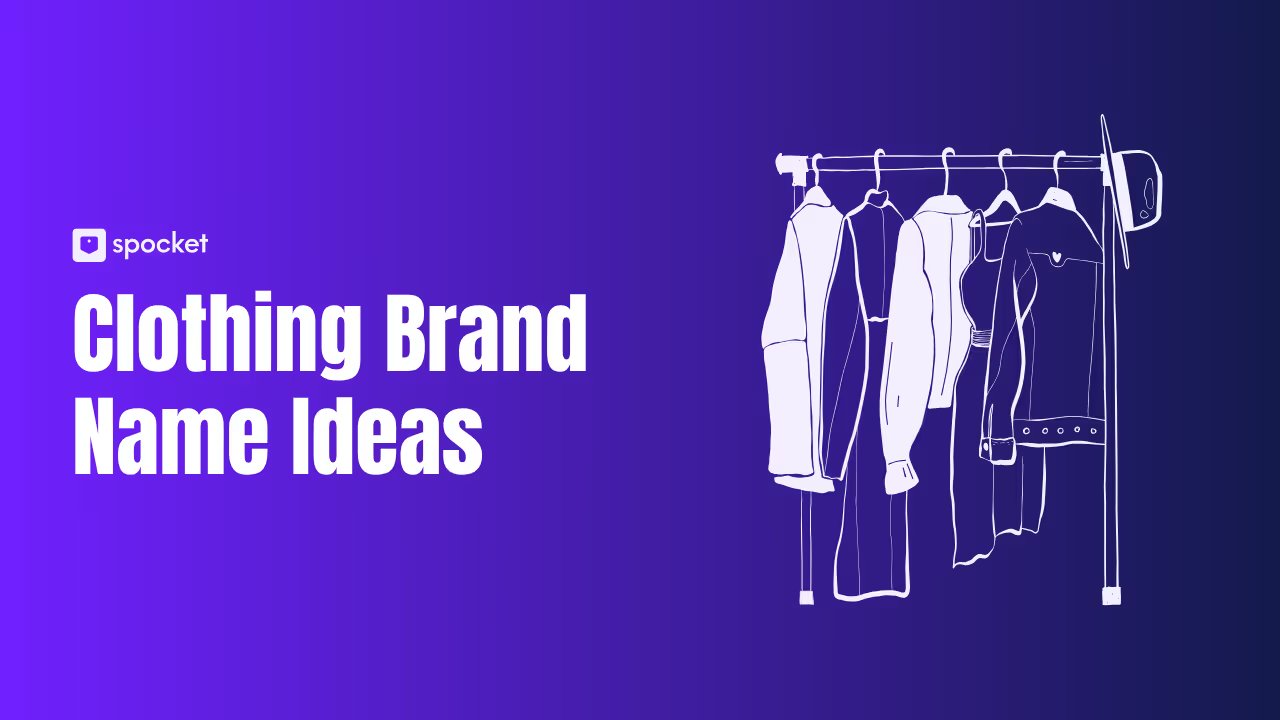Picking the right name for your clothing brand isn’t just about creativity—it’s about setting the foundation for your brand’s entire identity. Your brand name is the first thing people notice, and it can say a lot about who you are, what you stand for, and the vibe you want to share. Whether you’re launching a sleek, high-end fashion line or a fun, casual streetwear brand, your name will influence how potential customers connect with your products.
But here’s the catch: A good brand name doesn’t just look cool; it needs to reflect your values, resonate with your target audience, and stand out in a crowded market. In this guide, we’ll break down exactly how to choose a name that does all that and more—one that not only makes an impression but sticks with people long after they’ve seen it.
Key Factors to Consider When Creating Clothing Brand Name Ideas
.avif)
Creating the perfect name for your clothing brand isn’t a one-size-fits-all process. There are several important factors that can determine whether your brand name truly resonates with your audience and reflects the essence of your brand. This section will walk you through these key considerations to help you come up with a name that captures attention, builds a connection, and sets the foundation for your brand’s success.
Understand Your Target Audience: Name Strategies That Appeal to Your Market
Before you even begin brainstorming names, you need to know who you’re speaking to. Understanding your target audience is critical. The right brand name speaks directly to the people you want to connect with. For example, a high-end fashion line targeting affluent customers will likely benefit from a sophisticated name, while a casual clothing brand for millennials might opt for something trendy and approachable.
Your brand name should reflect the values, lifestyle, and aspirations of your target demographic. A name like “UrbanFit” speaks to a younger, active audience, while “Timeless Elegance” could resonate more with mature customers seeking sophistication. Taking the time to identify your ideal customer helps you choose a name that makes an immediate impact and starts building that crucial emotional connection.
The Importance of Market Research: Naming with Competitor Analysis in Mind
Once you have a clearer picture of your target audience, it's time to look at your competition. Market research allows you to understand naming conventions in your niche and spot trends. What are the most common types of names in your category—are they catchy, abstract, descriptive, or branded with initials?
Competitor analysis goes beyond simply choosing a name—it’s about ensuring that your brand stands out. If most competitors in the luxury clothing space are using abstract names, you might want to opt for something more evocative, like “LuxeThreads” or “GildedSilk.” On the other hand, if your competitors are using straightforward descriptive names, a creative or invented name might help you cut through the noise and grab attention.
By doing a thorough analysis of your competition, you can avoid using overused phrases and focus on building something unique.
Cultural Sensitivity and Global Relevance: Avoiding Brand Name Blunders
When creating a clothing brand, especially if you’re considering international expansion, cultural sensitivity is a must. What might be a stylish, catchy name in your country could have a completely different meaning elsewhere. Imagine naming your brand something trendy that, when translated into another language, might turn out to have negative or inappropriate connotations.
It's essential to ensure your name works across different cultures and regions. Take the time to research your name’s meaning in multiple languages, especially if you’re looking to appeal to a diverse audience. For instance, consider how “Nike” derived from the Greek goddess of victory—it’s a name that holds powerful meaning universally. Make sure your name doesn't unintentionally offend or confuse your target market by having multiple meanings.
Tools like Google Translate, native speaker consultations, or international focus groups can help you test the cultural relevance of your name and avoid costly blunders down the line.
The Legal Side: Trademarking and Domain Name Availability
Trademarking your brand name is a crucial step in protecting your business and ensuring that no one else uses your brand. Before you get too attached to your potential name, always check whether it’s available for trademark registration. A name that’s too similar to an existing trademark can cause legal headaches down the road.
Additionally, securing the right domain name for your website is just as important. The name you choose should be available as a domain, and you should check that your preferred social media handles are also available. Having consistency across your brand’s online presence is key to making it easy for your customers to find and recognize you.
Investing in legal checks, such as trademark searches and domain registration, will give you peace of mind and ensure your brand has the foundation it needs to grow without legal complications.
Creative and Effective Approaches for Clothing Brand Name Ideas
.avif)
Coming up with a great name for your clothing brand can be one of the most exciting aspects of building your business. There are countless creative approaches to finding the perfect name—whether you want it to be descriptive, unique, or a combination of both. In this section, we’ll explore several strategies to help you come up with a name that not only stands out but resonates with your audience.
Descriptive Brand Names: Conveying the Essence of Your Clothing Line
Descriptive names do exactly what they say—they describe your brand’s focus, mission, or the type of clothing you offer. The advantage of a descriptive name is its clarity. For example, if you sell eco-friendly clothing, a name like "GreenGarb" or "EcoThreads" instantly communicates your commitment to sustainability.
The main benefit of descriptive names is that they leave little room for confusion. Customers know right away what your brand is about. However, the downside is that descriptive names can sometimes lack uniqueness and creativity. If you're planning to diversify your product line in the future, a more flexible name might be better. But for a straightforward brand focused on a specific product or mission, descriptive names can be powerful.
Invented Names: How Unique Brand Names Spark Curiosity
Invented names are one of the most creative ways to make your brand stand out. These names don’t necessarily have any meaning on their own but become iconic over time due to strong branding and recognition. Consider names like “Nike” or “Zara” – they don’t immediately suggest what the brand sells, but they are memorable and unique.
Invented names can spark curiosity and intrigue, making customers want to learn more about your brand. The challenge, however, is that these names often require more marketing effort to explain the brand story and its offerings. But with the right branding and positioning, invented names can become incredibly powerful and memorable.
Combination Names: Merging Two Words to Create Something Catchy
Combination names involve blending two or more words to create a unique and memorable brand name. This method allows you to express the essence of your brand while maintaining a sense of originality. For example, "Lululemon" combines an unusual word with a catchy rhythm, while "H&M" uses the initials of its founders.
The beauty of combination names is that they can be both descriptive and inventive. You could combine two words that represent your brand's core attributes, like “ActiveStyle” for an athleisure line or “UrbanChic” for a trendy, city-inspired collection. This flexibility allows you to convey your brand’s identity while still keeping the name fresh and innovative.
Acronyms and Abbreviations: How to Make Your Clothing Brand Name Short & Sweet
Sometimes, less is more. Acronyms and abbreviations allow you to create a brand name that’s easy to say, spell, and remember. Famous brands like “GAP” or “GUESS” have perfected the art of acronym-based branding. These short names are snappy and impactful, making them easy to recall in a crowded marketplace.
The key to a good acronym is ensuring that the words behind it are relevant and meaningful. To get perfect acronym ideas related to your brand, you can consider giving a try to AI acronym generator. Acronyms like "H&M" (Hennes & Mauritz) or “GAP” (Great American Products) work well because they still hold meaning even in their abbreviated form. Acronyms also allow you to scale your brand later without being locked into a single product category.
Top Clothing Brand Name Ideas by Category
Now that we’ve covered some creative naming strategies, it's time to get specific. Here, we’ll explore categorized name ideas for different types of clothing brands. Whether you're launching a luxury line, casual wear, streetwear, or something else entirely, we’ve got you covered with unique name ideas to inspire your brand.
1. Luxury Clothing Brand Name Ideas
When it comes to luxury clothing brands, the name should immediately evoke a sense of sophistication, exclusivity, and elegance. These names aren’t just labels—they’re statements of high-quality craftsmanship and timeless style. Here are a few examples:
- Opulent Mode – A name that screams luxury and style, perfect for a high-end fashion line.
- Velvet Noir – Combining softness (velvet) and mystery (noir), ideal for a dark, chic clothing collection.
- LuxeLine – A sleek, modern name that positions your brand as premium and desirable.
Luxury names should feel refined and distinctive, so avoid generic or overly trendy terms. Focus on words that suggest quality, heritage, and a sense of exclusivity to attract high-end customers.
2. Casual Clothing Brand Name Ideas
For casual wear, you want names that are approachable, easygoing, and feel relatable to your target audience. These names should convey comfort, versatility, and everyday wearability. Here are a few casual clothing brand name ideas:
- EasyWear – Simple, yet effective. It speaks to the convenience of everyday clothes.
- ComfyThreads – Evokes comfort and ease, perfect for a casual, cozy brand.
- UrbanVibe – A more modern twist, ideal for casual wear with an urban flair.
Casual brand names should be easy to remember and make your customers feel like they’re getting something comfortable and accessible. These names should reflect the brand’s down-to-earth, approachable nature.
3. Streetwear Clothing Brand Name Ideas
Streetwear is all about bold, rebellious vibes. These brands need names that feel edgy, cool, and in tune with youth culture. Here are some streetwear clothing brand name ideas:
- HypeStreet – A combination of “hype” and “street” that feels fresh, bold, and aligned with street culture.
- UrbanKing – Exudes confidence and power, ideal for a brand that dominates the streetwear scene.
- RogueThread – A rebellious name that positions your brand as non-conformist and unique.
Streetwear names should reflect the underground, bold, and street-smart attitude of the fashion, so don’t be afraid to get creative with edgier, more unique terms.
4. Sustainable Clothing Brand Name Ideas
With sustainability at the forefront of modern fashion, your brand name should reflect a commitment to eco-friendly practices. These names should convey your values and tell a story of responsibility and conscious consumerism. Here are some sustainable clothing brand name ideas:
- GreenGarb – Simple, catchy, and directly related to sustainable fashion.
- EcoThread – Focuses on the environmental aspect while maintaining an easy-to-remember name.
- ConserveWear – A name that suggests conservation and eco-friendly production.
Sustainability is a key selling point for many customers today, and your brand name should make that clear right from the start. Choose words that communicate eco-consciousness, environmental responsibility, and positive impact.
5. Kids Clothing Brand Name Ideas
When it comes to kids' clothing, you want names that are fun, playful, and family-friendly. These names should appeal to both parents and children while conveying warmth, comfort, and joy. Here are a few examples:
- Lil’ Sprouts – Cute and playful, this name evokes images of little ones growing and flourishing.
- SnuggleBugs – Sweet and cuddly, perfect for a clothing brand focused on comfort.
- KiddoStyle – Simple and fun, this name is easy to remember and reflects a fashionable yet playful brand.
Kids’ clothing brand names should be relatable and approachable, offering parents the reassurance that the clothes are comfy, affordable, and stylish for their little ones.
How to Generate Clothing Brand Name Ideas Using AI & Online Tools
.avif)
While brainstorming brand names is a fun and creative process, it can also be a challenge to find the perfect one. Thankfully, there are numerous AI-powered tools and online resources available today that can help make the process easier and faster. In this section, we’ll dive into how you can leverage these tools to generate unique and creative clothing brand name ideas in no time.
Using AI to Find Perfect Clothing Brand Names
AI-powered name generators are one of the easiest and most effective ways to come up with creative brand names. Tools like Namelix, Shopify’s Business Name Generator, and Oberlo’s Name Generator use advanced algorithms to suggest brand names based on your input. These tools allow you to input keywords, industry types, or specific brand characteristics (e.g., eco-friendly, luxury, modern), and they will generate a list of potential names for you.
The beauty of AI-generated names is that they offer a wide variety of options that you might not have considered. They can suggest creative combinations of words, help you find names that are available as domains, and even recommend names that align with SEO best practices. AI tools are a quick and easy way to jumpstart your brainstorming process and get your creativity flowing.
Free Online Resources for Brainstorming Clothing Brand Names
If you prefer free tools or additional inspiration, there are plenty of other resources that can help you come up with a name for your clothing brand. Websites like NameMesh, Wordoid, and Namify offer a variety of name-generation services, many of which allow you to filter results based on industry, style, or availability.
For example, NameMesh helps you explore names based on different categories like common names, short names, and SEO-friendly options. Wordoid generates unique, catchy names using word combinations that sound natural and creative. Namify specializes in providing brand names that are short, memorable, and domain-friendly.
These free resources can give you fresh ideas and save you time by narrowing down your options based on your brand’s identity. Additionally, some of these sites provide domain checks to ensure the names you like are available, helping you avoid any future hassles.
Conclusion: Starting Your Clothing Brand with the Right Name
Choosing the right name for your clothing brand is a crucial first step in building a strong foundation for your business. It’s more than just a label—it’s an extension of your brand’s identity, values, and the emotional connection you aim to create with your customers. Whether you’re going for a descriptive, invented, or combination name, it’s important to ensure it reflects your brand's vision and resonates with your target market.
Take the time to research, use AI tools for inspiration, and test your name for cultural relevance and legal availability. A unique and memorable brand name can set you apart in the crowded fashion industry and help foster lasting brand loyalty. So, brainstorm creatively, secure your domain and trademarks early, and get ready to build your brand’s identity around the name you choose!






































